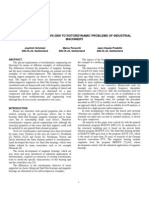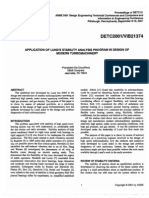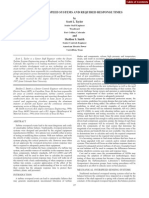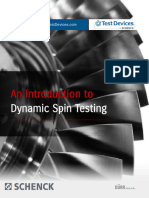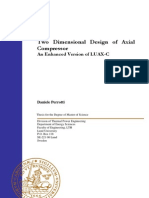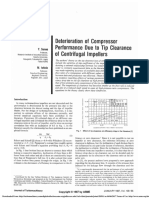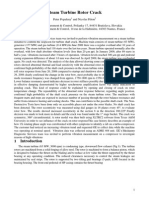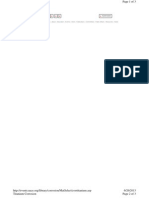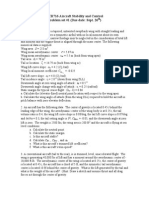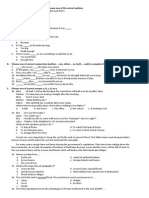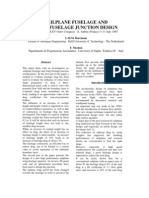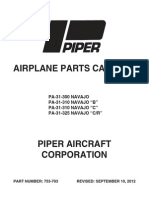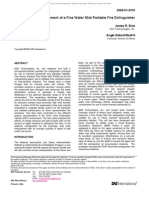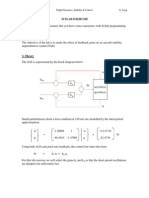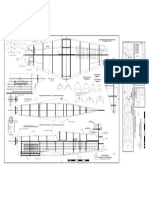Rotor Dynamics of Aircraft Gas Turbine Engines
Rotor Dynamics of Aircraft Gas Turbine Engines
Uploaded by
fengrotorCopyright:
Available Formats
Rotor Dynamics of Aircraft Gas Turbine Engines
Rotor Dynamics of Aircraft Gas Turbine Engines
Uploaded by
fengrotorOriginal Title
Copyright
Available Formats
Share this document
Did you find this document useful?
Is this content inappropriate?
Copyright:
Available Formats
Rotor Dynamics of Aircraft Gas Turbine Engines
Rotor Dynamics of Aircraft Gas Turbine Engines
Uploaded by
fengrotorCopyright:
Available Formats
INCAST 2008 - IT21
International Conference on Aerospace Science and Technology 26-28 June 2008, Bangalore, India
ROTOR DYNAMICS OF AIRCRAFT GAS TURBINE ENGINES
J. S. Rao
Chief Science Officer, Altair Engineering, Mercury 2B Block, 5th Floor, Prestige Tech Park, Bangalore, India js.rao@altair.com
Rankine defined critical speed of a rotor in 1869. Laval built the first impulse turbine in 1883 and ran his rotor upto 40,000 rpm by using an extremely flexible shaft. Jeffcott in 1919 formulated the rotor problem as one of forced vibration..Jeffcott models on 8 coefficient bearings are extensively used to study unbalance response, stability of practical rotors. Holzer in 1921 presented a tabular method to determine the torsional natural frequencies of systems, which can be discretized in the form of several rigid inertias, connected by massless torsional springs. Myklestad in 1944 extended Holzers approach for bending vibrations of aircraft wing type structures. Prohl adopted a similar tabular method in 1945 to determine the critical speeds of rotating shafts. This method has been used for a considerable period of time until it was replaced by transfer matrix forms for application by using computers. With the availability of computers by 1950s, both torsional and bending problems were initially expressed in Transfer Matrix form, and extensively used for torsional vibration under transient conditions of excitation such as electrical disturbances. The gyroscopic moment has a significant effect on the rotor dynamic behavior. Each natural frequency is split into two, one attributing to forward whirl and the second to backward whirl. The rotor whirls in a backward direction between these two critical speeds. For whirling rotors, bending in two planes is to be accounted. For solving unbalance response of rotors, 17x17 size matrices are employed. Fortunately, the overall transfer matrix still remains 17x17, and many industries still use codes based on transfer matrices, because of simplicity and less CPU time. Transfer matrices have been enhanced to account for twin spool rotor systems as adopted in modern aircraft engine power plants. The matrix size becomes 33x33. The inter-shaft bearing conditions have to be derived for each specific case and therefore the transfer matrix method has a limitation in making the procedure general in nature. Transfer matrix methods have serious limitations, e.g., in considering the gear mesh stiffness in a train. Another limitation is to consider the effect of casing/foundation stiffness on the rotor dynamics. Modern day design of rotors couples all these motions and it appears that the transfer matrix method will gradually be replaced by others in the very near future. The modern trend is to use finite element method to rotor dynamics, taking into account Timoshenko shear correction factor and gyroscopic effects. However, most use beam models even now which suffer from many disadvantages: 1.Real life rotors are not one-dimensional. 2. Considerable time and effort are involved in making the model, 3. The influence of disks on shafts, vice versa is not possible, 4. Centrifugal effects of distributed shafts and mounted parts cannot be accounted, 5. Gyroscopic effects are calculated as separate elements and the speed does not enter into the determination of critical speeds and 6. The foundation and casing effects are to be determined by sub-structuring analysis. An accurate rotor dynamic analysis needs solid models for the rotors. Analysis of solid rotor models progressed rapidly in the last few years. Initially an example of an aero-engine power plant twin spool rotor shown in Fig. 1 was considered to benchmark the results. The Campbell diagram is shown in Fig. 2. Forward whirl gradually increased from 100.2 Hz to 111.4 Hz, whereas the backward whirl dropped to 5.018 Hz. At 630 rad/s spin speed, there is only one frequency detected which is forward whirl 111.4 Hz. Thus the backward whirl is dominated by spin softening effect compared to the forward whirl frequencies where the stress stiffening plays a significant role. Beam models cannot predict the backward whirl modes as stress stiffening and spin softening influences cannot exist with the structure as a line element. Deriving beam models for real life engines is time consuming and arguable; the casing and support structure is very light in construction and therefore participates in coupled motion with the rotor. As a first step, for civil transport aircraft, this casing may be considered rigid. For modern state-of-art military aircraft engines, however, such a simplification creates problems. Recent advances give us the ability to use solid models directly resulting in Model-Mesh-Analyze approach to rotor dynamics. An aircraft engine mode shape is illustrated.
3000
2500 WHIRL SPEED (rad/s)
2000
1500
1000
500
0 0 500 1000 1500 2000 2500 3000 R O T O R 1 S P IN S P E E D ( ra d/s )
Fig. 1 A Twin Spool Solid Rotor Model
Fig. 2 Campbell Diagram
Fig. 3 Rotor Dynamics of an Aircraft Engine High speed cryogenic pumps in some cases run up to 100,000 rpm; the bearings become highly nonlinear and seals are responsible for instability regions. Internal pressures can also affect the stiffness of the flexible casing. Today it is possible to perform a nonlinear analysis and typical response of a high speed rotor as shown. High speed rotors are also required to accelerate from start up to full speed in 3-5 seconds. The response at which peak response is obtained can be obtained by transient analysis. The transient analysis for the unbalance response of a highly accelerating rotor is depicted.
Fig. 4 Rotor Dynamics of A High Speed Pump and Its Transient Response Rotors have mounted parts and Turbomachine Bladed disks are most stressed components, globally elastic but locally plastic and therefore subjected to fatigue failures, particularly when they have a material or manufacturing defect in the stress riser regions. Strain Based method is most appropriate to estimate life. Life estimation depends on how accurately the resonant stresses at a critical speed are determined. A major factor affecting this process until recently is an appropriate and realistic damping model. Todays technology allows us to analytically determine the damping due to material as well as friction in a given mode of vibration at a given speed of operation and as a function of reference strain amplitude, as shown in Fig. 5
0.18 0.16 0.14 0.12 0.1 0.08 0.06 0.04 0.02 0 0 0.00001 0.00002 Amplitude (m) 0.00003 0.00004 200 RPM 500 RPM 1000 RPM
Fig. 5 Analytically Predicted Combined Material and Friction Damping as a function of reference Strain Amplitude at a given Speed and in a given Mode of Vibration Life estimation process has become crucial at design stage and is illustrated in the following chart.
Steady Loads Centrifugal Loads Static Analysis Mean Stress Natural Frequencies Mode shapes Modal Analysis Dynamic Stress Critical speeds Damping Models Life Estimation Excitation Forces
Thermal Loads
Goodman Diagram S-N Law Failure Surface Cumulative Damage
Damping Ratio
True Stress Neubers Law Local Strain Strain based Crack Initiation Life
LEFM - SIF Crack Initiation
Crack Propagation Unstable Crack Fracture Life
The steady load analysis in the upper left hand side of chart 1 for mean stresses is well established; the main sources are centrifugal loads, thermal loads and gas loads. The dynamic stress module is usually complicated, particularly while estimating the alternating force definition and damping definition. Current practices of CFD allow an accurate determination of the force field in a turbine or compressor stage with moving row of blades. Modal analysis of rotating blades is a complex subject that attracted attention of researchers over the last five decades. The governing equation of this system can be derived from basic energy principles as given. Contributions of each term in the equation are identified in the same equation. Solutions for such highly nonlinear equation are complicated; they have been achieved for special cases, e.g., the response in fundamental mode under transient conditions. The nonlinear terms become important for long slender blades such as helicopter blades under acceleration. Fortunately many of these nonlinear and Coriolis terms have negligible influence in aircraft engine blades as far as forced vibration at critical speeds is concerned
in determination of stress field.
Translation and Rotational Inertias Beam Stiffness Stiffness due to rotation Hardening Softening
& &+ y
xx & & + y A
EI
xx y + + t 2 (R + Z ) y y R y + 0 2 A
Nonlinear Coriolis Forces
){
+2
l z & & dz y y & dz + t y y y y + 0 0 0
l 1 z 2 + y y y dz y ydz + (R + Z ) = 0 20 0 Force due to acceleration
independent of y Nonlinear terms due to acceleration
The natural frequencies and mode shapes of turbine and compressor blades are determined following well established Finite Element methods and commercial codes. Campbell diagram can then be drawn to identify the critical speeds. At these critical speeds, the damping is estimated as outlined. The resonant stress is determined using the nonlinear damping model by an iteration process and the stress variation around the critical speed is obtained by using dynamic magnifier relation. The steady state and dynamic stresses together are used in a cumulative damage calculation process to assess the life. This tedious and time consuming life estimation is recently developed as a user friendly code. Aircraft engines work in limits; they demand as high possible life that is permissible under globally elastic and locally plastic conditions and in addition minimum weight consistent with structural integrity. In earlier practices, dedicated codes are developed to achieve a specific optimization problem but are limited to one or two objective functions and few design constraints in a real life structural problem. Several attempts have been made in recent years to develop commercial user friendly optimization codes. One such general optimization code is Altair HyperStudy which uses global optimization methods. These methods use higher order polynomials to approximate the original structural optimization problem over a wide range of design variables. The polynomial approximation techniques are referred to as Response Surface methods. A sequential response surface method approach is used in which, the objective and constraint functions are approximated in terms of design variables using a second order polynomial. One can create a sequential response surface update by linear steps or by quadratic response surfaces. The process can also be used for non-linear physics and experimental analysis using wrap-around software, which can link with various solvers. A recent study demonstrated optimization of a blade root shape, the parameters varied consistent with manufacturing constraints and available space. The optimized root shape reduced plastic strain at the singularity by 26%. Using strain based method of lifing this strain reduction increased the life as much as 4 times. Another significant optimization reported recently is concerned with weight optimization. The lean stress regions are used to decrease the weight of the blade shank by 10%
Region of interest Optimized Shape Baseline Shape
(a) Shape
(b) Weight
Fig. 6 Blade Root Optimization
You might also like
- Bell 47G Illustrated Parts BreakdownDocument308 pagesBell 47G Illustrated Parts Breakdowntordo2275% (4)
- Wind Turbine Rotor Balance Static V Dynamic Rev4 ExtDocument14 pagesWind Turbine Rotor Balance Static V Dynamic Rev4 ExtmlenzNo ratings yet
- Component Reliability Report - 2020-11Document90 pagesComponent Reliability Report - 2020-11Fred Sagrera100% (1)
- Paper Rotor DynamicsDocument12 pagesPaper Rotor DynamicsTony HeNo ratings yet
- Rotor Dynamics Lund Stability CriteriaDocument6 pagesRotor Dynamics Lund Stability CriteriathunderNo ratings yet
- Ch15 TaylorDocument12 pagesCh15 Taylorramnadh803181No ratings yet
- Vortex Transport and Blade Interactions in High Pressure TurbinesDocument11 pagesVortex Transport and Blade Interactions in High Pressure Turbinesapi-19772009100% (1)
- 12 1989 Shaft StressDocument4 pages12 1989 Shaft StressRonald GeorgeNo ratings yet
- Advantages of High Speed BalancingDocument29 pagesAdvantages of High Speed BalancingAkshayNo ratings yet
- Dynamic Spin Testing-060220Document8 pagesDynamic Spin Testing-060220rymon.engineeringNo ratings yet
- Review of Rotor Balancing MethodsDocument16 pagesReview of Rotor Balancing MethodsFallo SusiloNo ratings yet
- Rotor Dynamic Modelling As A Powerfull Tool For Vibrartion Analysis of Large TurbomachineryIFTOMM 2010Document7 pagesRotor Dynamic Modelling As A Powerfull Tool For Vibrartion Analysis of Large TurbomachineryIFTOMM 2010sainath_84No ratings yet
- Polder Pumps ManualDocument7 pagesPolder Pumps ManualHiren PatelNo ratings yet
- Chapter-1 Steam Turbine TheoryDocument17 pagesChapter-1 Steam Turbine Theorybhaskar100% (1)
- Flow Phenomenon in Steam Turbine DiskDocument9 pagesFlow Phenomenon in Steam Turbine Diskrashm006ranjan100% (1)
- Rotordynamics: Bending Critical Speeds and Rotor Balancing: Politecnico Di Milano M.Sc. in Mechanical EngineeringDocument14 pagesRotordynamics: Bending Critical Speeds and Rotor Balancing: Politecnico Di Milano M.Sc. in Mechanical EngineeringArnab B.No ratings yet
- Analysis of Vibratory Stress of Integral Shroud BladeDocument12 pagesAnalysis of Vibratory Stress of Integral Shroud BladeRoshan Shanmughan100% (2)
- CO2 Compressor Reverse RotationDocument8 pagesCO2 Compressor Reverse RotationHoang ThangNo ratings yet
- Steam-Turbines 2 PDFDocument2 pagesSteam-Turbines 2 PDFGaneshsikarwarNo ratings yet
- Reblading Na 57Document3 pagesReblading Na 57Sumit SethNo ratings yet
- Oil Whirl Whip PDFDocument9 pagesOil Whirl Whip PDFbwelz100% (2)
- Appendix 6a - Technical Specifiction Spare Rotor Repair T10 and T20Document17 pagesAppendix 6a - Technical Specifiction Spare Rotor Repair T10 and T20Dino Andrian100% (1)
- Case Study Tuning Out Difficult Torsional Vibration ProblemDocument15 pagesCase Study Tuning Out Difficult Torsional Vibration Problempathakshashank100% (1)
- The Effect of Unbalance On Bearing LifeDocument8 pagesThe Effect of Unbalance On Bearing Lifemans2014100% (2)
- Com - CasingDocument25 pagesCom - CasingBianco BoualemNo ratings yet
- APD Dynamic StressesDocument11 pagesAPD Dynamic StressesadehriyaNo ratings yet
- Two Dimensional Design of Axial CompressorDocument160 pagesTwo Dimensional Design of Axial CompressorMarcusHuynh88No ratings yet
- OM Best Practices Frame 5 TurbomachineryDocument2 pagesOM Best Practices Frame 5 Turbomachineryan_iboreg8720No ratings yet
- Some Advantages of Welding Turbine Rotors PDFDocument10 pagesSome Advantages of Welding Turbine Rotors PDFAli VarmazyarNo ratings yet
- Steam Turbine-Part III - Trip and Throttle ValveDocument7 pagesSteam Turbine-Part III - Trip and Throttle ValveAahmer Hasan100% (1)
- 44 e 6Document10 pages44 e 6thlim19078656No ratings yet
- 1982 - Korner - Design Features of Steam PDFDocument6 pages1982 - Korner - Design Features of Steam PDFramakantinamdarNo ratings yet
- Forces On Large Steam Turbine Blades: RWE NpowerDocument5 pagesForces On Large Steam Turbine Blades: RWE NpoweradawNo ratings yet
- An Investigation of Transient Thermal Analysis of 1 Stage Gas Turbine Blade Manufactured by Directional Solidification and Mechanically Alloyed Nickel-Based SuperalloysDocument12 pagesAn Investigation of Transient Thermal Analysis of 1 Stage Gas Turbine Blade Manufactured by Directional Solidification and Mechanically Alloyed Nickel-Based SuperalloyshidaiNo ratings yet
- 1Q05 GasTurbineVibMonitoringDocument15 pages1Q05 GasTurbineVibMonitoringDimas Aji Kharisma Cakra100% (1)
- Dynamic of Bow RotorDocument20 pagesDynamic of Bow Rotormh1999100% (1)
- Deterioration of Compressor Performance Due To Tip Clearance of Centrifugal ImpellersDocument7 pagesDeterioration of Compressor Performance Due To Tip Clearance of Centrifugal ImpellersmedagamNo ratings yet
- Elecon High Speed Gearbox PDFDocument14 pagesElecon High Speed Gearbox PDFgaurang3005No ratings yet
- 3.1training - Manual - TBN Steam Path (Rotor)Document16 pages3.1training - Manual - TBN Steam Path (Rotor)Tung Nguyen100% (1)
- Causes of Rotor Distortions and Applicable Common Straightening Methods For Turbine Rotors and ShaftsDocument6 pagesCauses of Rotor Distortions and Applicable Common Straightening Methods For Turbine Rotors and Shaftsbigsteve9088No ratings yet
- Labyrinth SealDocument29 pagesLabyrinth Sealbambsoe100% (1)
- Impeller Repair Techniques For Centrifugal Compressors PDFDocument8 pagesImpeller Repair Techniques For Centrifugal Compressors PDFFonCKm09No ratings yet
- Diffuser Versus Volute Casing - PumpsDocument5 pagesDiffuser Versus Volute Casing - Pumpsjanamurali0% (1)
- Detection of Unbalance in Rotating Machines Using PDFDocument14 pagesDetection of Unbalance in Rotating Machines Using PDFKonstantinos KamarasNo ratings yet
- Troubleshooting Hot Gear DrivesDocument8 pagesTroubleshooting Hot Gear DrivesYuda SatriaNo ratings yet
- Practical Approach To Precision BalancingDocument4 pagesPractical Approach To Precision BalancingAbolfazl KhakiNo ratings yet
- Belt Installation and MaintenanceDocument6 pagesBelt Installation and Maintenancefaizan abbasiNo ratings yet
- GER4724 Torsional Dynamics PaperDocument16 pagesGER4724 Torsional Dynamics PaperBilal AllouhNo ratings yet
- Review of Rotor BalancingDocument8 pagesReview of Rotor BalancingLasse HansenNo ratings yet
- Journal BearingDocument7 pagesJournal BearingFarhan TalibNo ratings yet
- Triveni Brochure - OEMDocument24 pagesTriveni Brochure - OEMshashikiran.gskNo ratings yet
- Turbine BladeDocument19 pagesTurbine BladeParvin Surwade100% (1)
- Steam Turbine Rotor CrackDocument11 pagesSteam Turbine Rotor Crackpoloko7100% (2)
- M PM 170Document34 pagesM PM 170mahesh_eilNo ratings yet
- Evaluation of Tilting Pad Thrust Bearings PDFDocument10 pagesEvaluation of Tilting Pad Thrust Bearings PDFVILLANUEVA_DANIEL2064No ratings yet
- The Book of the Singer Junior - Written by an Owner-Driver for Owners and Prospective Owners of the Car - Including the 1931 SupplementFrom EverandThe Book of the Singer Junior - Written by an Owner-Driver for Owners and Prospective Owners of the Car - Including the 1931 SupplementNo ratings yet
- Towards Rotordynamic Analysis With COMSOL Multiphysics Towards Rotordynamic Analysis With COMSOL MultiphysicsDocument5 pagesTowards Rotordynamic Analysis With COMSOL Multiphysics Towards Rotordynamic Analysis With COMSOL MultiphysicsjaypallaNo ratings yet
- Gas Turbine Response On Seismic Load: Y. Temis, M. Temis, A. EgorovDocument10 pagesGas Turbine Response On Seismic Load: Y. Temis, M. Temis, A. Egorovrodrigo manquelafquenNo ratings yet
- Paper CT4 Load Assumptions For Pitch System Manj 041Document5 pagesPaper CT4 Load Assumptions For Pitch System Manj 041mbreuking6943No ratings yet
- CFD Analysis of Swept and Leaned Transonic Compressor RotorDocument5 pagesCFD Analysis of Swept and Leaned Transonic Compressor RotorseventhsensegroupNo ratings yet
- Research Article: Dynamic Characteristics of Air Cycle Machine Rotor SystemDocument17 pagesResearch Article: Dynamic Characteristics of Air Cycle Machine Rotor SystemEmandi RajeshNo ratings yet
- InTech-Wind Turbine Gearbox TechnologiesDocument18 pagesInTech-Wind Turbine Gearbox TechnologieshamdimouhhiNo ratings yet
- Chapter 3Document15 pagesChapter 3Bheemesh GudelliNo ratings yet
- Airspace FlashcardsDocument12 pagesAirspace FlashcardsHeisson Sanchez100% (3)
- Missile Guidance PDFDocument22 pagesMissile Guidance PDFjamesyblee50% (2)
- Laminated Paper Airplane 07655 InstructionsDocument2 pagesLaminated Paper Airplane 07655 InstructionsMugenNo ratings yet
- 2Document30 pages2sarmadNo ratings yet
- Titanium Corrosion PDFDocument3 pagesTitanium Corrosion PDFSellappan MuthusamyNo ratings yet
- Check List EMB 711 CoriscoDocument4 pagesCheck List EMB 711 CoriscoVinícius Souto Simão0% (1)
- R/C Soaring Digest - Apr 2011Document28 pagesR/C Soaring Digest - Apr 2011Aviation/Space History LibraryNo ratings yet
- 04a Torsion of ThinWalled StructuresDocument35 pages04a Torsion of ThinWalled StructuresYan NingNo ratings yet
- AER716Document1 pageAER716OpenTalk0% (1)
- A. Complete The Following Sentences, Choose One of The Correct OptionsDocument2 pagesA. Complete The Following Sentences, Choose One of The Correct OptionsAnang Safi'uddinNo ratings yet
- Robert NobleDocument17 pagesRobert NobleLava Sat100% (1)
- QR Questions DatabaseDocument49 pagesQR Questions DatabaseIury AlencarNo ratings yet
- Stall Protection: Howden Axial Fan Retrofit SolutionDocument2 pagesStall Protection: Howden Axial Fan Retrofit SolutionKoushik Dey100% (1)
- Sailplane Fuselage and Wing Junction DesignDocument10 pagesSailplane Fuselage and Wing Junction DesignTinusAppelgrynNo ratings yet
- Ijes Project FileDocument17 pagesIjes Project FilebhargavNo ratings yet
- PC 753-703Document1,031 pagesPC 753-703Jeffrey Dee100% (2)
- Expt 4 Conclusion and ApplicationsDocument2 pagesExpt 4 Conclusion and ApplicationsW0% (2)
- TBM 700 Maintenancerunup R47Document15 pagesTBM 700 Maintenancerunup R47thilo eckardtNo ratings yet
- Advances in Development of A Fine Water Mist Portable Fire ExtinguisherDocument9 pagesAdvances in Development of A Fine Water Mist Portable Fire ExtinguisherpvekzNo ratings yet
- Jeppview For Windows: List of Pages in This Trip KitDocument33 pagesJeppview For Windows: List of Pages in This Trip KitGeorgiy DaneliaNo ratings yet
- The Untold Story of Lynne Stewart and Egyptair Flight 990Document7 pagesThe Untold Story of Lynne Stewart and Egyptair Flight 990Alan Jules WebermanNo ratings yet
- Manual4241 SciLabDocument3 pagesManual4241 SciLabevandame5739No ratings yet
- Full-Scale Testing and Progressive Damage Modeling of Sandwich Composite Aircraft Fuselage StructureDocument493 pagesFull-Scale Testing and Progressive Damage Modeling of Sandwich Composite Aircraft Fuselage StructureAlaa ElsisiNo ratings yet
- Keith Rider R4 Oz13321 VectorDocument1 pageKeith Rider R4 Oz13321 Vectoradd2mixNo ratings yet
- AMT-200S Maint ManualDocument75 pagesAMT-200S Maint ManualLuis Amaya50% (2)
- Aeroshell Specification GuideDocument2 pagesAeroshell Specification GuidemertaktayNo ratings yet



